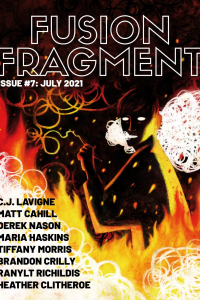Faren Miller reviews Catherynne M. Valente
Few writers have a voice and vision as unique as Catherynne M. Valente’s when she’s delving into arcane realms of myth and legend. She went there in The Book of Dreams (2005), and now in The Habitation of the Blessed. (Last year’s Palimpsest edged closer to contemporary urban fantasy with its sex and tattoos, though it ultimately defied cliché.)
Frame story ‘‘The Confessions of Hiob von Luzern, 1699’’ features a Christian scholar and explorer on a quest for the kingdom of Prester John, a figure from medieval Christian legend. Outside a humble village near the Indus River, Hiob and his apprentice encounter a magical tree that sprouts books, introducing three other narratives whose entwined chapters come to dominate Habitation. Occasional reappearances of ‘‘Confessions’’ might feel like a sleeper’s brief periods of waking in a night of bizarre dreams, were they any less peculiar in their own right. While he tries to concentrate on reading and transcribing, Hiob finds out just how far he is from Luzern: maddeningly, these books mildew and rot, like any fruit too long off the tree. Text vanishes and cannot be recovered, only guessed at or mourned in passing.
All three interpolated tales (what we get of them) resemble diaries from the same era, hundreds of years before Hiob’s cusp of the 18th century, and the first two pertain directly to his quest – though not at all as he expected. ‘‘The Word in the Quince’’ is Prester John’s account of his own pilgrimage into an East populated by a Boschian array of monsters and quasi-humans, most of which Valente takes from genuine ancient and medieval writers’ ‘‘accounts’’ of inhabitants in distant lands (creatures even more outrageous than space aliens in the Pulps). ‘‘The Book of the Fountain’’ counters this with a native’s perspective. For Hagia, it’s entirely normal to be headless, with eyes displaced to her breasts and mouth to her stomach. John’s the oddity:
The newcomer disquieted me. Most everyone else, it seemed, considered him a marvelous new toy: it talked and walked and made such charming noises when proven wrong. Imagine! The poor thing did not know about trees or the Fountain… or even what an astomi was!
Unlike her fellows, she’s driven to find out more about him. Why did he stumble into her world with so many misconceptions? Is he really limited to one short mortal life?
Valente’s readers (even those whose education extends to Herodotus, medieval legends, and the byroads of religion) may have the most trouble finding their bearings in the book-tree’s final product, ‘‘The Scarlet Nursery’’. For much of this one Imtithal, AKA Butterfly, tends to the children of Queen Abir in a great city that could be Constantinople, though its inhabitants appear no more human than the creatures of the Fountain in the forest – and just as unaware of any strangeness. With her white eyes and huge, winglike ears (capable of ‘‘eating’’ sound), Imtithal looks nothing like her charges; their enormous feature is their hands. Ironically, these young royals adore myths and legends, so she serves as a kind of Scheherezade for them: tales within tales!
Habitation’s most extraordinary invention is its magical trees, which were a much more varied bunch in John’s time (the book-tree is a relic). In scenes that could have come from the pen of Swift, Valente sends her future king stumbling into a realm where edible war-trees produce anything an army might need, from cannons to horses. Nearby, pious sheep-trees sneer at the worshippers of any gods but their own supreme deity, Shear. In pulp fiction, such a wild setting and characters could be enough in themselves, and even satire might not go much beyond ensuring that absurdities reflect the things they mock. Here though, everything mentioned so far is just the start. Whether wry, ridiculous or majestic, the background ultimately serves to explore our concepts of normality, reality, and the beliefs vital to an enlightened life… or not.
The talespinning nurse proves to be an atheist who tells one of the children ‘‘No, my golden-eyes. There is only us, making and watching and loving and punishing. Only us, sleeping below the stars.’’ Hagia the headless female, a scribe, prefers translation to describing her own life, a task that leaves her ‘‘buffeted by didacticism, digression, daydreams.’’ Lost in the bizarre forest with most of his old beliefs exposed as sad delusions, John feels ‘‘as though every story I had ever heard had broken itself on the shores of this place like blind, brittle whales, and I walked among their shards, that could never be made whole again.’’ Though the people of the Fountain aren’t Christians, that religion shows up in many guises: as legend in the nurse’s tales, as a desperate mystery for John and Hiob, and even as a topic for debate between man and gryphon!
This is only the first book in a larger project, A Dirge for Prester John. Its interpolated narratives both hint at further action and develop their own complications. No doubt the mix of drama, comedy, mad inventions, and philosophy will be just as extraordinary in the volumes still to come, where the fate of kingdoms is at stake.









Pingback:Linking Out « Torque Control